PCF Female Straight — One-Touch Push-In Fitting for Compressed Air
PCF Female Straight is a one-touch female straight push-in fitting engineered for compressed air systems. It delivers fast, tool-free tube connection and disconnection, a compact hexagonal body engineered for tight installations, and pre-applied thread coating for simplified assembly. Designed for reliability in pneumatic systems, the PCF family is available in a wide range of tube diameters and thread sizes to suit industrial automation, machine-building, and facility compressed air distribution.
Introduction
Push-in fittings (also called push-to-connect or one-touch fittings) have become a de facto standard for pneumatic installations because they significantly reduce assembly time, require no special tools, and simplify maintenance. The PCF Female Straight is a purpose-built member of this category with an emphasis on space efficiency, quick servicing, and robust sealing for compressed air applications. Its hexagonal body permits tightening within confined spaces, and seal-coated threads reduce the need for on-site thread sealing procedures.
This article provides a deep technical dive into the PCF Female Straight fitting, covering its functional design, materials, dimensions, technical specifications, typical applications, installation best practices, maintenance guidance, and a balanced analysis of strengths and limitations versus alternative fittings.
Technical Overview
The PCF Female Straight is a push-in (one-touch) pneumatic fitting with a female threaded port and a straight push-fit tube connection. The product is designed for compressed air only and supports quick make-and-break connections without tools. Key operational characteristics are:
- One-touch connection: Insert tube into the push-in port until it seats; the internal collet and O-ring form an immediate seal and mechanical grip.
- Quick release: Depress the release sleeve (collet) and withdraw the tube to disconnect in 1–2 seconds.
- Compact hex body: Hexagonal inner and outer surfaces allow tightening with a wrench even in confined spaces, reducing installation footprint.
- Seal-coated threads: Threads are pre-coated with a thin PTFE or equivalent sealing film at the factory to simplify assembly and reduce risk of leaks caused by incorrect thread sealing methods.
- Performance range: Rated for 0–150 psi (0–990 kPa) working pressure and capable of withstanding vacuum down to -29.5 in Hg (-750 mm Hg, approx. 10 Torr).
- Operating temperature: 0–60°C (32–140°F), specified for standard NBR elastomer seals and common thermoplastic/thermoresistant bodies used in compressed air systems.
Internal functional elements
Internally, the PCF Female Straight consists of the following functional subassemblies:
- Body: Provides the threaded connection and housing for the collet and sealing elements. The external geometry includes flats for wrenching.
- Collet (retainer): Typically stainless steel or spring steel; grips the inserted tubing and features a release ring to unlock for disconnection.
- Release sleeve: Plastic or acetal ring that the operator depresses to release the collet’s grip.
- O-ring or sealing element: Elastomer seal (commonly NBR) that compresses on tube insertion to form an air-tight seal.
- Threaded port: Female port finished with a factory application of sealing coating (PTFE film or lacquer) to improve leak-tightness and ease of installation.
When a tube is inserted, it passes through a centering guide and engages the O-ring; the collet teeth bite lightly into the tube’s outer wall to prevent axial pull-out while maintaining seal integrity. The fitting is serviceable: the collet and seal can be replaced in-field if wear or damage is detected.
Specifications and Dimensions
The table below presents representative technical dimensions and specifications for common PCF Female Straight models. The values are typical millimetric measurements used for layout, routing, and selection. Always refer to the manufacturer’s product datasheet for certified dimensions and tolerances before finalizing a design.
| Model Code | Tube OD | Typical Tube ID | Thread Size / Type | Outer Hex AF (mm) | Inner Hex AF (mm) | Overall Length (A) (mm) | Thread Length (B) (mm) | Tube Insertion Depth (C) (mm) | Weight (g) | Max. Working Pressure | Operating Temp. | Vacuum |
|---|---|---|---|---|---|---|---|---|---|---|---|---|
| PCF 04-1/8 | 4 mm | 2.0–2.5 mm | 1/8″ BSPP / NPT* | 10 | 6 | 28 | 8 | 12 | 6 | 0–150 psi (0–990 kPa) | 0–60°C | -29.5 in Hg |
| PCF 06-1/8 | 6 mm | 4.0–4.2 mm | 1/8″ BSPP / NPT* | 10 | 7 | 30 | 8 | 14 | 8 | 0–150 psi | 0–60°C | -29.5 in Hg |
| PCF 08-1/8 | 8 mm | 5.0–5.5 mm | 1/8″ or 1/4″ | 12 | 8 | 34 | 9 | 15 | 12 | 0–150 psi | 0–60°C | -29.5 in Hg |
| PCF 10-1/4 | 10 mm | 6.0–6.5 mm | 1/4″ | 14 | 10 | 40 | 11 | 17 | 18 | 0–150 psi | 0–60°C | -29.5 in Hg |
| PCF 12-1/4 | 12 mm | 8.0–8.5 mm | 1/4″ | 17 | 12 | 45 | 12 | 18 | 28 | 0–150 psi | 0–60°C | -29.5 in Hg |
| PCF 16-1/2 | 16 mm | 12.0–12.5 mm | 1/2″ | 22 | 16 | 58 | 15 | 21 | 55 | 0–150 psi | 0–60°C | -29.5 in Hg |
Notes: Thread type depends on the specific model configuration — the PCF product family is often available in BSPP (parallel), NPT (taper), and metric G/M thread variants. Values above are representative and should be verified with manufacturer datasheets for precise engineering. Thread seals are pre-applied; do not stack PTFE tape over factory seal coating unless explicitly advised by the manufacturer.
Materials and Build Quality
The PCF Female Straight is built to deliver a balance of mechanical robustness and resistance to typical industrial contaminants encountered in compressed air systems. Typical material choices and the rationale for them are described below.
Body
- Material options: Brass (nickel-plated), engineering plastics such as PBT (polybutylene terephthalate) or PPS (polyphenylene sulfide) for corrosion-resistant variants.
- Advantages: Brass offers excellent mechanical strength, thread integrity, and durability, making it suitable for repeated assembly/disassembly. Plastics reduce weight, cost, and improve corrosion resistance for non-metallic system requirements.
Collet and Retainer
- Material: Stainless steel or spring steel for the collet teeth and retainer ring.
- Function: Ensures reliable grip on tubing across repeated connect/disconnect cycles; stainless variants improve corrosion resistance and lifetime in humid environments.
Sealing Elements
- O-rings: Nitrile rubber (NBR) is the standard because it offers good sealing performance with compressed air at the specified temperature range. EPDM or FKM (Viton) options may be available for higher chemical or temperature resistance but will affect temperature and media compatibility.
- Seal-coated threads: Factory-applied PTFE-based film or a proprietary sealing lacquer reduces the need for on-site tape or paste and provides a consistent, thin, controlled sealing layer that is resistant to vibration-induced loosening.
Release Sleeve
- Material: Acetal (POM) or PBT in most implementations; selected for dimensional stability, low friction, and wear resistance.
Durability and Testing
High-quality PCF fittings undergo cyclic testing for repeated connect/disconnect operations (commonly >500–1,000 cycles under nominal conditions), pressure-hold tests at and beyond rated pressure to verify burst safety margins, and vacuum testing for leak performance at negative pressures. Materials are chosen to avoid corrosion, galling on threads, and degradation of elastomers due to oil and condensate exposure in compressed air systems.
Key Features
The PCF Female Straight provides a compact, service-friendly solution for pneumatic connections. Key features include:
- True one-touch operation: Tube insertion and release in seconds — no ferrules, nuts, or special tools required.
- Compact hexagonal body: Outer and inner hex flats allow wrench tightening in restricted spaces while minimizing profile.
- Seal-coated threads: Factory-applied sealing coating simplifies assembly and reduces installation error compared to manual PTFE tape application.
- Wide size availability: Metric tube diameters (4, 6, 8, 10, 12, 16 mm) and inch tube sizes (5/32″, 1/8″, 1/4″, 5/16″, 3/8″, 1/2″) accommodate standard tubing systems.
- Pressure and vacuum capability: Rated to 0–150 psi (0–990 kPa) and vacuum to -29.5 in Hg (approx. 10 Torr), enabling use in both supply and certain vacuum-return applications.
- Quick serviceability: Replaceable O-rings and retainer elements simplify repairs and spare-part management.
- Reusability: Designed for multiple assembly cycles without performance degradation when used within specified limits.
Use Cases and Applications
The PCF Female Straight is primarily designed for compressed air distribution and control in industrial environments. Typical use cases include:
Industrial Automation and Machine Building
Used for pneumatic actuation (cylinders, grippers), valve manifolds, and linear actuators. The quick-connect feature speeds up OEM assembly lines and field servicing of industrial equipment.
Packaging and Material Handling
Compact fittings are ideal where machinery has tight clearances and numerous pneumatic connections (e.g., pick-and-place systems, conveyors). Fast maintenance turnaround time reduces equipment downtime.
Robotics and End-Of-Arm Tooling (EOAT)
Robotic end-effectors often require frequent reconfiguration; one-touch fittings allow rapid re-routing and repair of pneumatic lines while the hex body enables installation in confined spaces between robotic joints.
Facilities and Pneumatic Distribution
Compressed air drop lines, service islands, and point-of-use outlets benefit from quick-connect fittings to allow rapid connection of hoses and tools.
Light Vacuum and Suction Applications
Because the PCF fitting is vacuum-capable down to approximately 10 Torr, it can be used for low-vacuum pick-and-place suction circuits in packaging and assembly operations. Note: verify seal material compatibility for prolonged vacuum service.
Maintenance, Repair, and Overhaul (MRO)
Service technicians favor push-in fittings for temporary connections, testing, and temporary bypass setups while diagnosing system issues. The fittings’ reusability reduces spare part complexity.
Comparison with Alternative Fittings
Below is a comparative view of the PCF Female Straight against two common alternatives: a generic long-body push-in fitting and a traditional compression (union/ferrule) fitting.
| Attribute | PCF Female Straight | Generic Long-Body Push-In | Compression (Ferrule) Fitting |
|---|---|---|---|
| Installation Speed | Very fast — one-touch insert; seconds | Fast — similar one-touch but larger profile | Slower — nut tightening and ferrule seating required |
| Space Footprint | Compact hex body for tight installations | Longer profile; less suited to confined spaces | Moderate; requires space for nut wrenching |
| Thread Sealing | Factory seal-coated threads | Usually plain threads; user-applied tape | Depends — metal-to-metal or user-applied tape |
| Reusability | High — designed for many cycles | High — similar durability | Good but ferrules can be single-use in some designs |
| Vibration Resistance | Good when properly tightened; collet grip reduces axial creep | Similar | Excellent axial retention; ferrule offers metal compression |
| Cost | Moderate | Moderate | Varies — can be higher for stainless/precision ferrules |
| Serviceability | Very easy — quick release for tubing changes | Very easy | Less convenient for frequent reconfiguration |
| Best Use Case | Pneumatic point-of-use, tight spaces, frequent changes | General-purpose push-in applications | High-pressure, critical sealing, or permanent assemblies |
This comparison highlights why the PCF Female Straight is a strong choice where space and speed are priorities, while compression fittings remain preferable for permanent, high-integrity metal sealing applications in critical fluid systems (especially liquids or oils). For compressed air specifically, the PCF fitting provides a balanced mix of performance and convenience.
Benefits and Limitations
Benefits
- Significant time savings: Tool-free connections translate into faster assembly and reduced labor cost.
- Compact design: The hex body minimizes profile and facilitates tightening in cramped assemblies.
- Consistent thread sealing: Factory-applied coating reduces variability and leak risk from poor workmanship.
- Reusability and serviceability: Replaceable internal components allow repairs in the field instead of full part replacement.
- Versatile size options: Compatible with a broad range of tubing sizes common in industrial pneumatic systems.
- Vacuum capability: Suited for light vacuum and suction circuits, expanding the use cases beyond pure supply lines.
Limitations
- Media limitation: Recommended for compressed air only unless higher-grade seals (e.g., FKM) are specified; not suitable for aggressive chemicals or hot liquids without verification.
- Temperature range: The standard NBR seals limit operation to 0–60°C. Extended temperature ranges require specialized seal materials.
- Thread compatibility: Care must be taken to order the correct thread type (BSPP vs NPT vs metric). Mismatched threads can leak or strip.
- Pressure ceiling: Rated to 150 psi; not suitable for higher pressure hydraulic or special pneumatic applications without certified high-pressure variants.
- Tubing compatibility: Push-in fittings require tubing with appropriate wall stiffness and surface finish. Soft or damaged tubing may not provide reliable seal or retention.
Installation and Best Practices
Proper installation maximizes leak-free performance and extends service life. Below are recommended steps and best practices for installing PCF Female Straight fittings.
Pre-installation checks
- Confirm the correct model for the tubing OD and thread type. Check model code (e.g., PCF 06-1/8) against system requirements.
- Inspect tubing for straightness, burrs, or deformities at the cut end. Replace damaged sections.
- Ensure tubing is compatible — common acceptable materials include polyurethane (PU), nylon (PA), and soft polyethylene. Avoid hard metallic tubing unless using a compatible adapter.
- Verify pipe thread specification: BSPP (parallel), NPT (tapered), or metric threads. Torque values differ by thread standard.
Cutting and tube preparation
- Cut tubing squarely using a proper tubing cutter. Avoid slanted cuts and deformation.
- Remove any burrs or shards that could damage the O-ring. Lightly chamfer tube ends if necessary (typical chamfer 15°–30° up to 0.2 mm).
- Measure insertion depth — mark the tube at the recommended insertion depth (see product datasheet) so the tube is fully seated against the internal stop.
Thread installation
- Apply a controlled torque in line with the fitting’s recommended torque range. Recommended torque ranges (typical) are below — always consult the manufacturer for final values:
- 1/8″ thread: 4–6 Nm
- 1/4″ thread: 8–12 Nm
- 1/2″ thread: 14–20 Nm
- Do not over-torque. Excess torque can damage threads, crack plastic bodies, or compress factory-applied seal coating unevenly.
- Factory seal-coated threads generally eliminate the need for additional tape or paste; if the environment or code requires extra sealing, consult the manufacturer before applying additional sealant.
Connecting the tube
- Insert the tube straight into the push-in port until it contacts the internal stop. A slight audible “click” may be felt on larger diameters.
- Confirm positive retention by lightly pulling the tube — it should not withdraw without depressing the release sleeve.
- For pressure testing, perform a low-pressure leak check (e.g., 1–2 bar) and inspect for bubbles using a leak detector or soapy water at threaded joints and tube seal area.
Disconnecting
- Depress the release sleeve evenly and pull the tube out while keeping the sleeve depressed.
- On high-vibration or pressurized disconnection, momentarily relieve downstream pressure before attempting to disconnect to prevent sudden ejection of tubing.
Maintenance and Care Guide
Routine maintenance preserves sealing integrity, prevents unexpected failures, and prolongs life. The following guidance helps maintenance engineers plan preventive measures and spare part inventories.
Periodic inspection
- Visual inspection: Check for cracks, corrosion, or damage to the body and release sleeve during scheduled inspections (monthly or quarterly depending on duty cycle).
- Leak test: Perform leak detection whenever system integrity may be compromised (e.g., after vibration events, reconfiguration, or long idle periods).
- Tube condition: Inspect the tubing at the connection point for wear, flattening, or damage caused by abrasion or tensile loading.
Component replacement
- Replace O-rings if leaks are detected or during overhauls — O-rings are inexpensive and restore original sealing performance.
- If the collet teeth become worn or the release sleeve no longer provides smooth operation, replace the collet assembly to prevent premature tubing release.
- Keep spare parts on-hand: O-rings, collets, and release sleeves are the most common field-replaceable items.
Cleaning
- Use clean, dry compressed air and a lint-free cloth to remove dust and particulates from the exterior.
- Do not use aggressive solvents on standard NBR seals; isopropyl alcohol is usually acceptable, but always validate chemical compatibility with seal material.
- For more aggressive cleaning needs, consult the manufacturer for guidance on compatible elastomer materials or higher-grade fitting variants.
Storage
- Store fittings in a clean, dry environment away from direct sunlight and extreme temperatures to avoid elastomer degradation.
- Keep fittings in sealed packaging until installed to preserve factory-applied thread coating and avoid contamination of O-rings.
Troubleshooting
Common issues and recommended remedial actions:
- Leak at threaded connection: Verify correct thread type and engagement depth. Lightly remove and re-seat the fitting; if leakage persists, inspect the thread coating and apply a compatible thread sealant as recommended.
- Tube slips out: Check for correct tube OD, verify insertion to the internal stop, and inspect collet teeth for wear. Replace collet if teeth are rooded or flattened.
- Difficulty inserting tube: Inspect the tube end for burrs or size mismatch. Re-cut square and clean the tube end and reinsert.
- Intermittent leaks under vibration: Ensure proper torque on the threaded connection and consider using a thread-locking washer or locknut if mechanical movement is causing loosening. Confirm that tubing is adequately supported to minimize cyclic stress at the joint.
Selection Checklist
Before specifying a PCF Female Straight fitting for a project, confirm the following:
- Tube OD/ID matches the fitting model
- Thread standard matches mating port (BSPP vs NPT vs metric)
- Operating pressure and vacuum requirements fall within rating (0–150 psi, vacuum to -29.5 in Hg)
- Temperature range is compatible with material selection (0–60°C for standard NBR)
- Media is compressed air (or verify elastomer compatibility for special cases)
- Environmental conditions (corrosion, chemicals) justify brass or plastic bodies and stainless internal components
Regulatory and Safety Considerations
Compressed air systems carry specific hazards (stored energy, particulate matter, oil carryover) that must be managed. When specifying or installing PCF Female Straight fittings, ensure compliance with applicable safety standards and organizational safety procedures:
- Depressurize systems prior to maintenance or replacement of fittings.
- Adhere to local standards for compressed air system design and personnel protection (e.g., ISO 4414 for pneumatic fluid power in some jurisdictions).
- Use appropriate filtration and condensate removal to reduce contamination that can degrade sealing elements.
Conclusion
The PCF Female Straight one-touch push-in fitting is an efficient, compact, and service-friendly solution for compressed air pneumatic systems. Its one-touch operation reduces installation time and maintenance overhead, while the hexagonal body and factory-applied thread sealing enhance usability in confined spaces and reduce assembly variability. With a working pressure rating up to 150 psi and vacuum capability down to approximately 10 Torr, the fitting suits a wide set of industrial automation, packaging, robotics, and facility pneumatic requirements.
As with any precision pneumatic component, correct selection, proper installation, and routine maintenance are essential to ensure predictable, long-term performance. Engineers should verify thread types, tube compatibility, and operating environment to select the correct PCF variant and to determine any need for higher-grade seal materials or corrosion-resistant body options.
When specified and installed per manufacturer recommendations, the PCF Female Straight offers a reliable, rapid, and compact method for building and servicing compressed air systems — making it a practical choice for OEMs, machine builders, and maintenance organizations seeking to optimize uptime and reduce installation complexity.
Keywords: PCF Female Straight, push-in fitting, one-touch fitting, push-to-connect, compressed air fitting, seal-coated threads, pneumatic fitting, quick-disconnect fitting, metric tube, vacuum-rated, hex body fitting.

 Tiếng Việt
Tiếng Việt
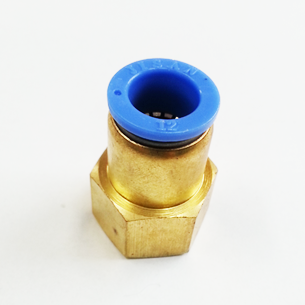
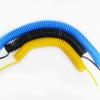
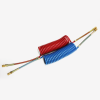
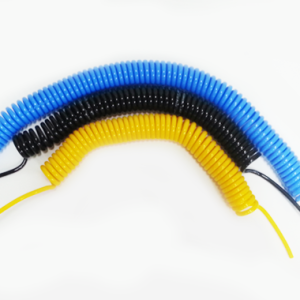
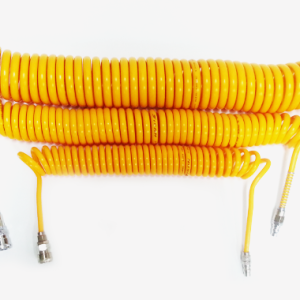
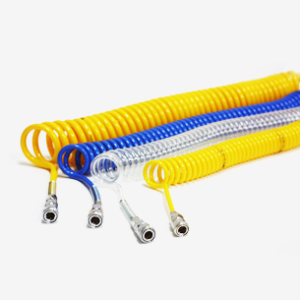
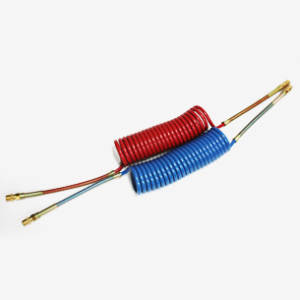
Reviews
There are no reviews yet.